A Parametric Study Investigating the Dowel Bar Load Transfer Efficiency in Jointed Plain Concrete Pavement Using a Finite Element Model
Abstract
1. Introduction
- Lateral or horizontal translation: When the dowel bar is located far enough from its specified position, this is defined as horizontal translation [16].
- Longitudinal translation: If the dowel bar centroid does not match with the transverse joint, this is referred to as longitudinal translation [18].
- Horizontal or vertical skew: The rotation of the dowel bar in a horizontal plane relative to the pavement centreline is known as horizontal skew. Conversely, vertical tilt is the rotation of the dowel bar in a vertical plane relative to the pavement surface [17].
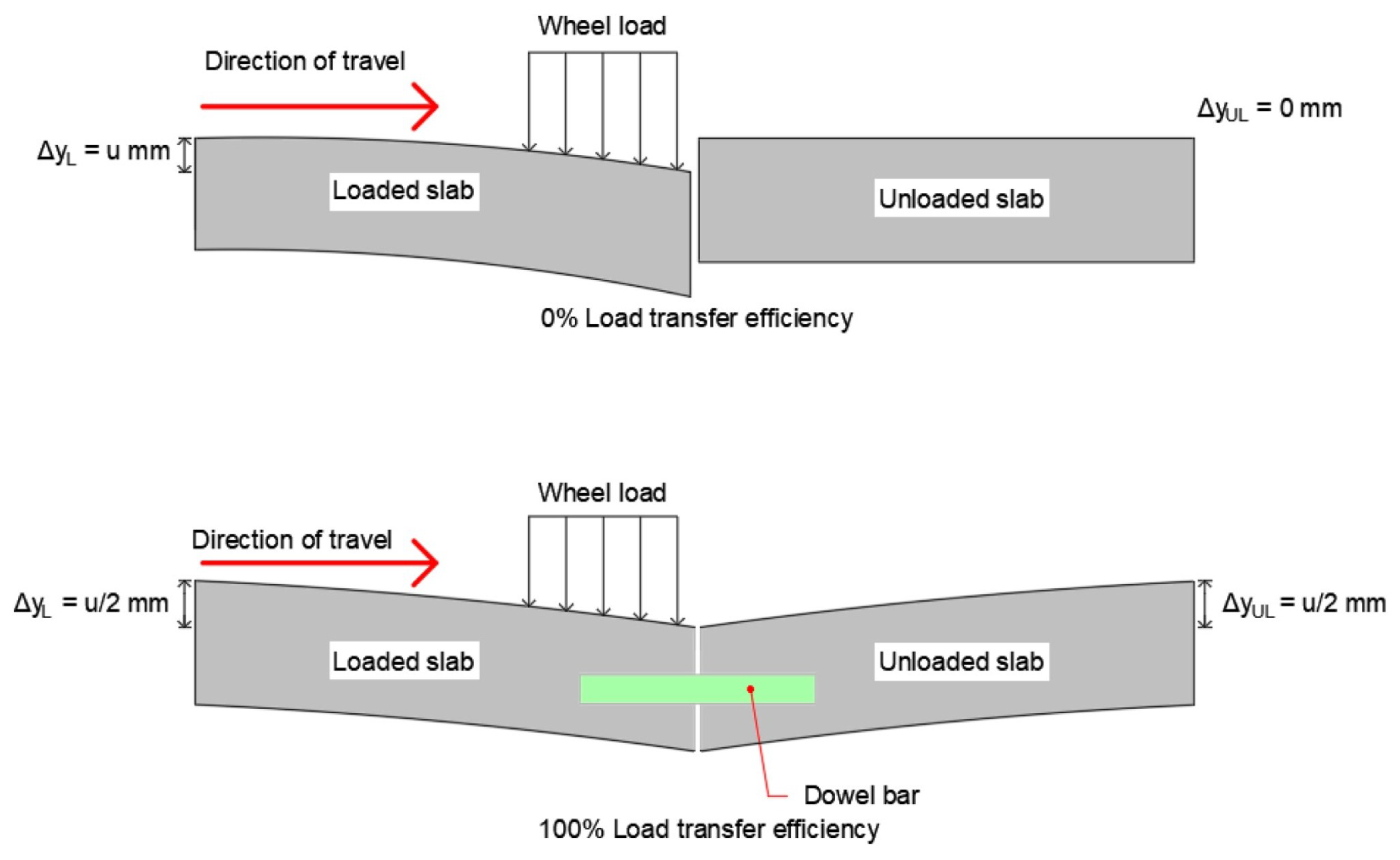
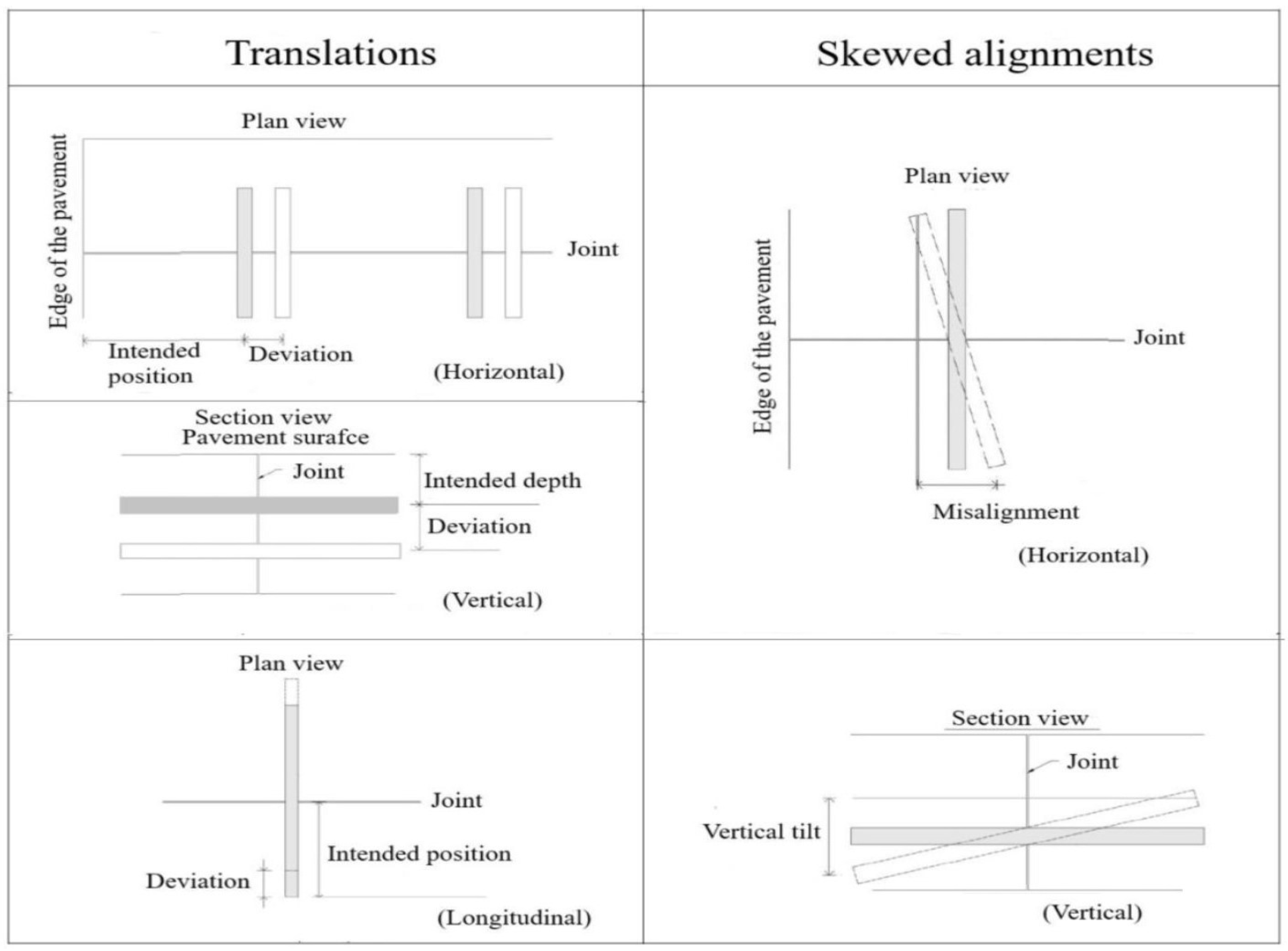
2. Aims and Objectives
- •
- Evaluate the effect of different positions of the dowel bar (at the top, bottom, and mid-height of the concrete slab) on LTE and flexural stress in the concrete slab;
- •
- Identify the influence of the joint opening on the LTE;
- •
- Identify the effect of mislocation of the dowel bar (horizontal, vertical, and longitudinal translations) on the LTE;
- •
- Examine the influence of the dowel bar diameter on the LTE;
- •
- Analyse the impact of the bond between the concrete slab and the dowel bar on the LTE.
3. Westergaard Method
- where,
4. Development of a 3D Finite Element Model
4.1. Geometry and Loads
4.2. Material Properties
4.3. Interactions
4.4. Boundary Conditions
4.5. Meshing
5. Results and Discussion
5.1. Comparison of the FE Model with the Westergaard Method
5.2. The Effect of Dowel Bar Position on the Load Transfer Efficiency
5.3. The Effect of Joint Opening on the Load Transfer Efficiency
5.4. The Effect of the Mislocation of Dowel Bar on the Load Transfer Efficiency
5.5. The Effect of Dowel Bar Diameter on the Load Transfer Efficiency
5.6. The Effect of Bonding between the Concrete Slab and Dowel Bar on Load Transfer Efficiency
6. Conclusions
- The results demonstrate that the maximum LTE is accomplished when the dowel bar is placed at the mid-height of the concrete slab. In addition, higher flexural stress develops in the concrete slab when the dowel bar is located at the bottom height of the concrete slab.
- During winter, the joints open as the concrete slab contracts, potentially causing issues in transferring wheel loads. This study observed a 2.1% reduction in LTE as the joint width increased from 2 mm to 12 mm. Conversely, the LTE improved by 3% with an increase in the diameter of the dowel bar. The dowel bar diameters considered in this study were 20 mm, 25 mm, 32 mm, and 38 mm.
- The study shows that the mislocation of the dowel bar (i.e., horizontal, vertical, and longitudinal translations) has a minimal impact on LTE. An approximate 2.1% difference in LTE was noted for horizontal and longitudinal translations of the dowel bar, while for vertical translation, the reduction in load transfer was around 0.5%. However, a marginal increase in LTE of approximately 0.5% was observed with an increased bond at the interface of the concrete slab and the dowel bar.
7. Future Research
Author Contributions
Funding
Data Availability Statement
Conflicts of Interest
References
- Maitra, S.R.; Reddy, K.S.; Ramachandra, L.S. Load transfer characteristics of aggregate interlocking in concrete pavement. J. Transp. Eng. 2010, 3, 190–195. [Google Scholar] [CrossRef]
- Delatte, N. Concrete Pavement Design, Construction, and Performance; Taylor & Francis: Abingdon, UK; New York, NY, USA, 2008; pp. 25–27. [Google Scholar]
- Guo, H.; Sherwood, J.A.; Snyder, M.B. Component dowel-bar model for load-transfer systems in PCC pavement. J. Transp. Eng. 1995, 121, 289–298. [Google Scholar] [CrossRef]
- Snyder, M. Guide to Dowel Load Transfer Systems for Jointed Concrete Roadway Pavements; Institute for Transportation: Ames, IA, USA, 2011. [Google Scholar]
- Yaqoob, S.; Silfwerbrand, J.; Strömberg, L. Evaluation of rapid repair of concrete pavements using precast concrete technology: A sustainable and cost-effective solution. Nord. Concr. Res. 2021, 65, 107–128. [Google Scholar] [CrossRef]
- Tayabji, S. FHWA Project R05 IAP Funded Project Case Study: Honolulu Interstate H1 Precast Concrete Pavement Demonstration Project; Federal Highway Administration (FHWA): Washington, DC, USA, 2016. [Google Scholar]
- Tayabji, S. FHWA Project R05 IAP Funded Project Case Study: Mobile Ramp Precast Concrete Pavement Demonstration Project; Federal Highway Administration (FHWA): Washington, DC, USA, 2017. [Google Scholar]
- Federal Highway Administration. Concrete Pavement Joints (Technical Advisory, T 5040.30); Federal Highway Administration: Washington, DC, USA, 2019.
- Tayabji, S. Guide Specification for Jointed Precast Concrete Pavement: [techbrief]; Federal Highway Administration: Washington, DC, USA, 2019. [Google Scholar]
- Smith, K.; Harrington, D.; Pierce, L.; Ram, P.; Smith, K. Concrete Pavement Preservation Guide, 2nd ed.; National Concrete Pavement Technology Center: Ames, IA, USA, 2014. [Google Scholar]
- ACPA. Dowel Bar Alignment and Location for Placement by Mechanical Dowel Bar Insertion; American Concrete Pavement Association Guide Specification: Skokie, IL, USA, 2013. [Google Scholar]
- Sturges, T.; Frankhouser, A.; Abbas, A.R. Evaluation of dowel bar alignment from a two-step dowel bar inserter. Int. J. Pavement Eng. 2014, 15, 438–448. [Google Scholar] [CrossRef]
- Khaki, A.M.; Azadravesh, E. Generating a 3D model for evaluating the joint opening effects on load transfer efficiency in concrete pavements, using Abaqus. In Proceedings of the 5th National Congress on Civil Engineering, Mashhad, Iran, 4–6 May 2010. [Google Scholar]
- Shoukry, S.N.; William, G.W.; Riad, M.Y. Evaluation of Load Transfer Efficiency Measurement; West Virginia University, Department of Civil and Environmental Engineering: Morgantown, WV, USA, 2005. [Google Scholar]
- Yu, H.T.; Tayabji, S. Best practices for Dowel Placement Tolerances; Federal Highway Administration: Washington, DC, USA, 2007. [Google Scholar]
- ACPA. Dowel Bar Alignment and Location; American Concrete Pavement Association Guide specification: Rosemont, IL, USA, 2018. [Google Scholar]
- ACPA. Evaluating and Optimizing Dowel Bar Alignment; American Concrete Pavement Association Guide specification: Rosemont, IL, USA, 2006. [Google Scholar]
- Kivi, A.K. Dowel bar alignment in concrete pavements—21st century standards and methods. In Proceedings of the Transportation Association of Canada 2020 Conference and Exhibition—The Journey to Safer Roads, Toronto, ON, Canada, 21 September–8 October 2020. [Google Scholar]
- Rao, S.; Hoegh, K.; Yu, T.; Khazanovich, L. Evaluation of dowel alignment constructability in Portland cement concrete pavements. J. Transp. Res. Board 2009, 2098, 86–93. [Google Scholar] [CrossRef]
- Tayabji, S. Dowel placement tolerances for concrete pavements. J. Transp. Res. Board. 1986, 10625, 47–54. [Google Scholar]
- Rens, L. Guide for the Design of Jointed Plain Concrete Pavements; EUPAVE (European Concrete Paving Association): Brussels, Belgium, 2003. [Google Scholar]
- Grosek, J.; Zuzulova, A.; Brezina, I. Effectiveness of Dowels in Concrete Pavement. Materials 2019, 12, 1669. [Google Scholar] [CrossRef] [PubMed]
- Mackiewicz, P. Analysis of stresses in concrete pavement under a dowel according to its diameter and load transfer efficiency. Can. J. Civ. Eng. 2015, 42, 845–853. [Google Scholar] [CrossRef]
- Mackiewicz, P. Finite-element analysis of stress concentration around dowel bars in jointed plain concrete pavement. J. Transp. Eng. 2015, 141, 1–8. [Google Scholar] [CrossRef]
- Khazanovich, L.; Hoegh, K.; Snyder, M. Guidelines for Dowel Alignment in Concrete Pavements; National Cooperative Highway Research Program, Transportation Research Board: Washington, DC, USA, 2009. [Google Scholar]
- Odden, T.R.; Snyder, M.; Schultz, A.E. Performance Testing of Experimental Dowel Bar Retrofit Designs, Part 1—Initial Testing; University of Minnesota, Department of Civil Engineering. Transportation Research Board: Minneapolis, MN, USA, 2003. [Google Scholar]
- Shoukry, S.N.; William, G.W.; Riad, M. Characteristics of concrete stresses in doweled transverse joints. Int. J. Pavement Eng. 2002, 3, 117–129. [Google Scholar] [CrossRef]
- Davids, W.G.; Wang, Z.; Turkiyyah, G.; Mahoney, J.P.; Bush, D. Three-dimensional finite element analysis of jointed plain concrete pavement with EverFE2.2. Transp. Res. Rec. 2003, 1853, 92–99. [Google Scholar] [CrossRef]
- Yancong, Z.; Lingling, G. Effect of dowel bar position deviation on joint load-transfer ability of cement concrete pavement. Int. J. Pavement Res. Technol. 2016, 9, 30–36. [Google Scholar]
- Shoukry, S.N.; William, G.W.; Riad, M.Y. Motamarri, S.S. Effect of Bonding Force on Stresses in Concrete Slab; West Virginia Department of Transportation: Charleston, WV, USA, 2003. [Google Scholar]
- Breeman, W.V. Experimental Dowel Installation in New Jersey. Bull. Highw. Res. Board 1955, 34, 8–33. [Google Scholar]
- Mackiewicz, P. Thermal stress analysis of jointed plane in concrete pavements. Appl. Therm. Eng. 2014, 73, 1169–1176. [Google Scholar] [CrossRef]
- Maitra, S.R.; Reddy, K.S.; Ramachandra, L.S. Load transfer characteristics of dowel bar system in JPCP. J. Transp. Eng. 2009, 135, 813–821. [Google Scholar] [CrossRef]
- Davids, W.G. Effect of dowel looseness on response of jointed concrete pavements. J. Transp. Eng. 2000, 126, 50–57. [Google Scholar] [CrossRef]
- Sii, H.W.; Chai, G.W.; Staden, R.V.; Guan, H. Effect of dowel looseness on response of jointed concrete pavements using three-dimensional finite element analysis. Adv. Mater. Res. 2014, 900, 435–444. [Google Scholar] [CrossRef]
- Silva, E.R.; Balbo, J.T.; Cargnin, A.P. Effects of dowel bars misalignment in jointed plain concrete pavements—A numerical analysis considering thermal differentials and bonded slab-base interface. IBRACON Struct. Mater. J. 2021, 14, 1–14. [Google Scholar] [CrossRef]
- Kim, K.; Chun, S.; Han, S.; Tia, M. Effect of dowel bar arrangements on performance of jointed plain concrete pavement (JPCP). Int. J. Concr. Struct. Mater. 2018, 12, 39. [Google Scholar] [CrossRef]
- Nishizawa, T.; Koyanagawa, M.; Takeuchi, Y.; Kimura, M. Study on mechanical behaviour of dowel bar in transverse joint of concrete pavement. In Proceedings of the 7th International Conference on Concrete Pavements, Orlando, FL, USA, 9–13 September 2001. [Google Scholar]
- Sadeghi, V.; Hesami, S. Investigation of load transfer efficiency in jointed plain concrete pavements (JPCP) using FEM. Int. J. Pavement Res. Technol. 2018, 11, 245–252. [Google Scholar] [CrossRef]
- Sargand, S.M.; Hazen, G.A.; Bazeley, C.C.; Copley, J.R.; George, M.E. Instrumentation of a Rigid Pavement System; Ohio Department of Transportation, Federal Highway Administration: Columbus, OH, USA, 1997. [Google Scholar]
- Leong, P.; Tighe, S.; Rothenburg, L.; Hein, D. Finite difference modelling of misaligned dowel bars and their effects on joint performance. Transp. Res. Rec. 2006, 1946, 101–110. [Google Scholar] [CrossRef]
- Prabhu, M.; Varma, A.H.; Buch, N. Experimental and analytical investigation of mechanistic effects of dowel misalignment in jointed concrete pavements. Transp. Res. Rec. 2007, 2037, 12–29. [Google Scholar] [CrossRef]
- Strömberg, L.; Silfwerbrand, J.; Ansell, A.; Hintze, S. Making concrete pavements competitive by using the standardised framework for comparisons of Infrastructure projects in terms of cost-efficiency and climate impact. Nord. Concr. Res. 2020, 62, 21–39. [Google Scholar] [CrossRef]
- Yaqoob, S. Concrete Pavements’ Repair Techniques and Numerical Assessment of Dowel Bar Load Transfer Efficiency. Licentiate Thesis, KTH Royal Institute of Technology, Stockholm, Sweden, 2024. [Google Scholar]
- Silfwerbrand, J. Concrete pavements for modern Swedish highways. In Proceedings of the 14th International Symposium on Concrete Roads, Krakow, Poland, 25–28 June 2023. [Google Scholar]
- Yaqoob, S.; Silfwerbrand, J. Rapid repair of concrete pavement using precast technology. In Proceedings of the 14th International Symposium on Concrete Roads, Krakow, Poland, 25–28 June 2023. [Google Scholar]
- Tayabji, S. Precast Concrete Pavement Technology Implementation; Federal Highway Administration (FHWA): Washington, DC, USA, 2019. [Google Scholar]
- Tayabji, S. Load Transfer Systems for Jointed Precast Concrete Pavement: [techbrief]; Federal Highway Administration (FHWA): Washington, DC, USA, 2015. [Google Scholar]
- Smith, P.; Snyder, M. Manual for Jointed Precast Concrete Pavement, 3rd ed.; National Precast Concrete Association (NPCA): Washington, DC, USA, 2019. [Google Scholar]
- Pierce, L.M.; Weston, J.; Uhlmeyer, J.S. Dowel Bar Retrofit-Do’s and Don’ts; Washington (State). Department of Transportation—Office of Research and Library Services: Olympia, WA, USA, 2009. [Google Scholar]
- Dhawale, A.W.; Vishwanath, M. Comparative study of wheel load stress and warping stress on concrete pavements. Int. J. Civil Struct. Environ. Infrastruct. Eng. Res. Dev. (IJCSEIERD) 2014, 4, 9–14. [Google Scholar]
- Westergaard, H.M. Stresses in Concrete Pavements Computed by Theoretical Analysis. Public Roads 1926, 7, 25–35. [Google Scholar]
- Teller, L.W.; Sutherland, E.C. The structural design of concrete pavements, Part 3—A case study of concrete pavement cross sections. Public Roads 1935, 16, 45–65. [Google Scholar]
- Teller, L.W.; Sutherland, E.C. The structural design of concrete pavements, Part 4—A study of the structural action of several types of transverse and longitudinal joint designs. Public Roads 1936, 17, 67–114. [Google Scholar]
- Teller, L.W.; Sutherland, E.C. The structural design of concrete pavements, Part 5—Experimental study of the Westergaard analysis of stress conditions in concrete pavement slabs of uniform thickness. Public Roads 1943, 23, 115–160. [Google Scholar]
- Kelley, E.F. Application of the research results to the structural design of concrete pavements. Public Roads 1939, 20. [Google Scholar]
- Eisenmann, J. Betonfahrbahnen. Handbuch für Beton-, Stahlbeton-und Spannbetonbau; Verlag von Wilhelm Ernst & Sohn: Berlin, Germany; München, Germany; Düsseldorf, Germany, 1979. [Google Scholar]
- Petersson, Ö. Svensk Metod för Dimensionering av Betongvägar; Licentiatavhandlig, Kungl Tekniska Högsklan Institutioen för Byggkonstruktion: Stockholm, Sweden, 1996. [Google Scholar]
- Silfwerbrand, J. Dimensionering av Betongbeläggningar, (Design of Concrete Pavements); KTH Royal Institute of Technology, Department of Structural Mechanics and Engineering: Stockholm, Sweden, 1995. [Google Scholar]
- Dassault Systems. Simulia User Assistance 2021. Available online: https://www.3ds.com/support/documentation/user-guides (accessed on 14 January 2024).
- AB Svensk Byggtjänst. Betong på Mark (Handbok) (Concrete slabs on grade [Handbook]); AB Svensk Byggtjänst: Stockholm, Sweden, 2002; p. 253. (In Swedish) [Google Scholar]
- STA. ATBVÄG: Allmän Teknisk Beskrivning för vä Gkonstruktioner; Swedish Transport Administration: Stockholm, Sweden, 2003. (In Swedish)
- Chen, F.; Balieu, R.; Kringos, N. Thermodynamics-based finite strain viscoelastic-viscoplastic model coupled with damage for asphalt material. Int. J. Solids Struct. 2016, 129, 61–73. [Google Scholar] [CrossRef]
- El-Matty, A.E.A.; Hekal, G.M.; El-Din, E.M.S. Modeling of dowel jointed rigid airfield pavement under thermal gradients and dynamic loads. Civ. Eng. J. 2016, 2, 38–51. [Google Scholar] [CrossRef]
- Caliendo, C.; Parisi, A. Application of the results of research to the structural design of concrete pavements. J. Transp. Eng. 2010, 136, 664–667. [Google Scholar] [CrossRef]

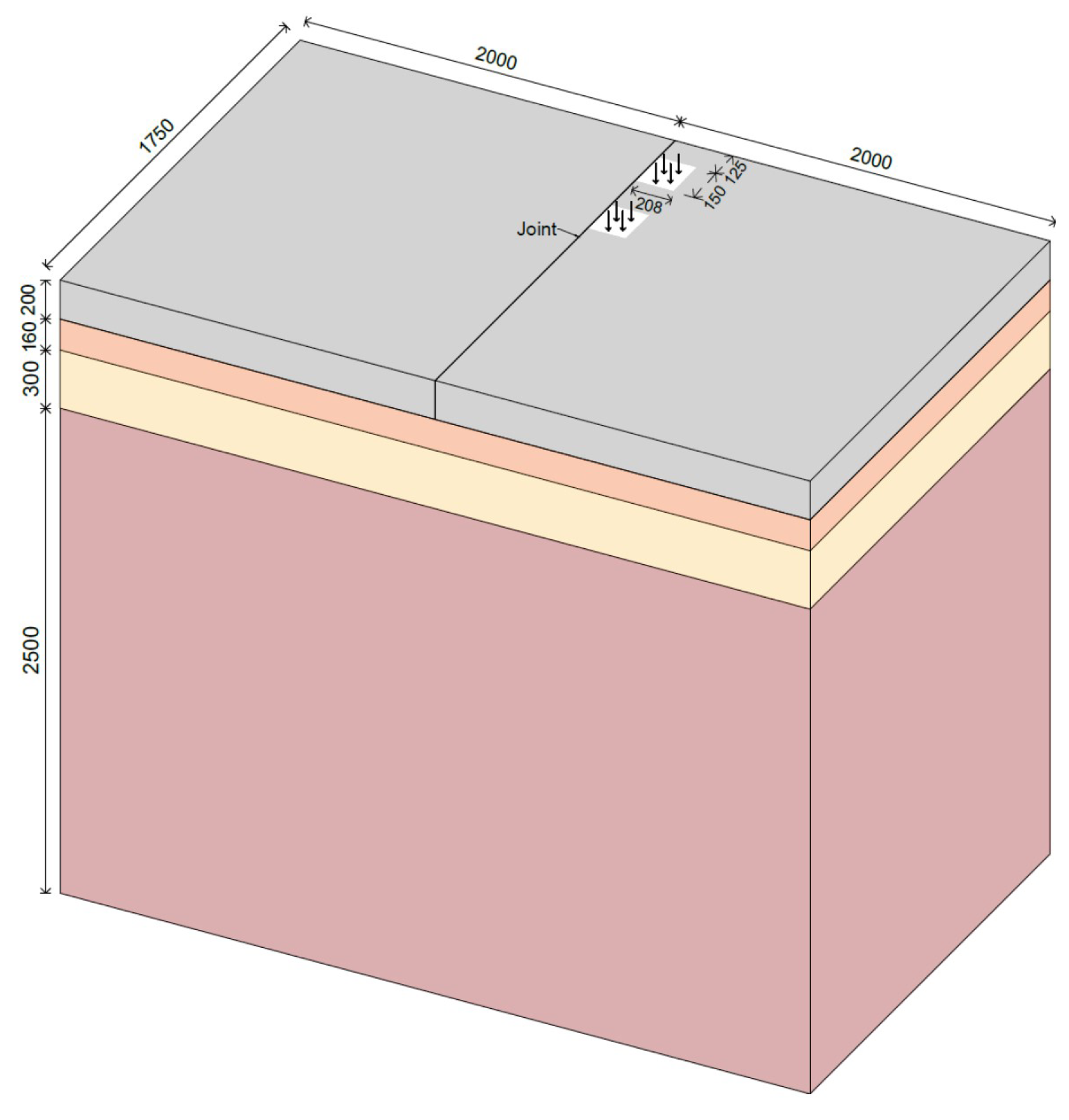
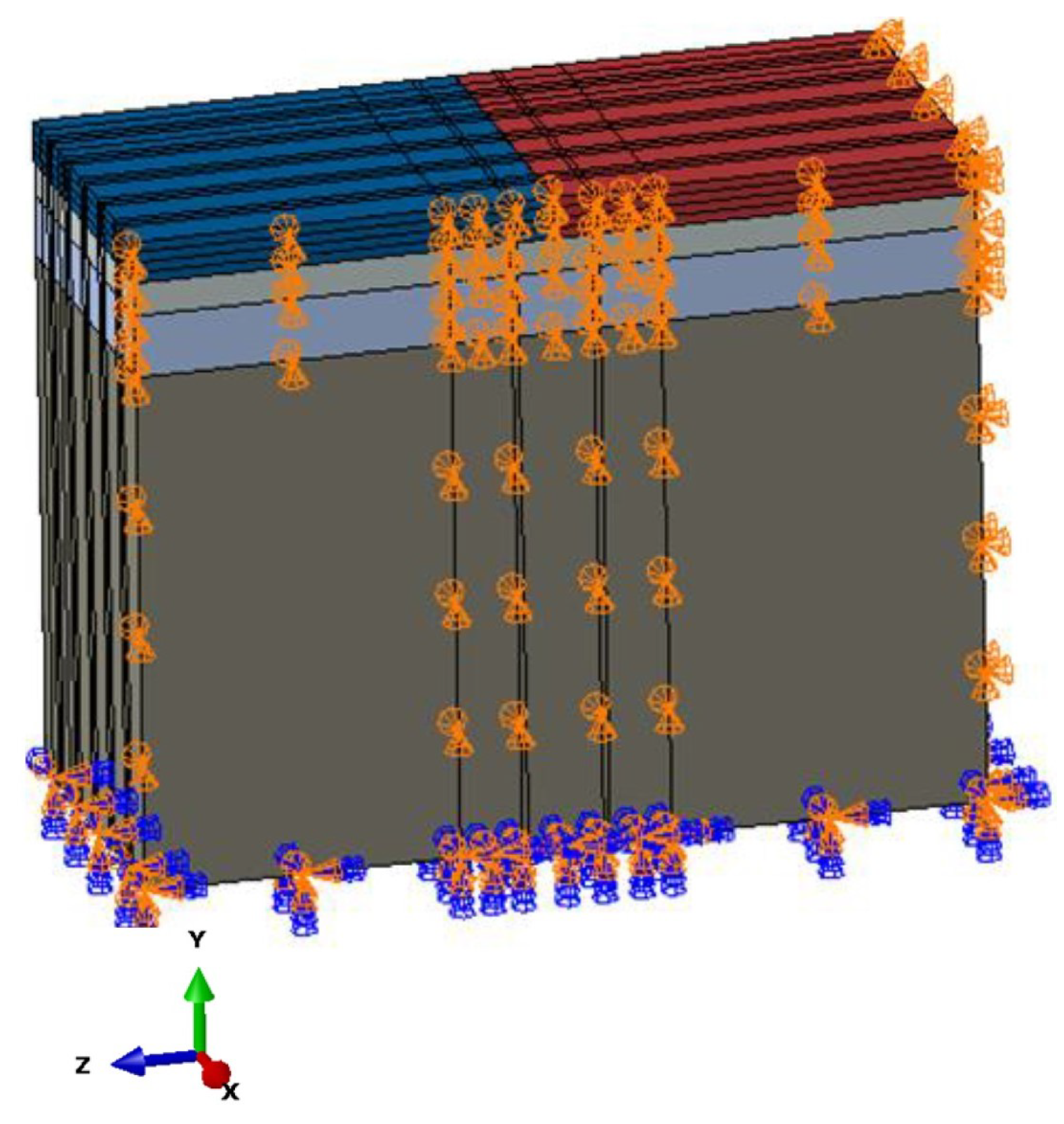

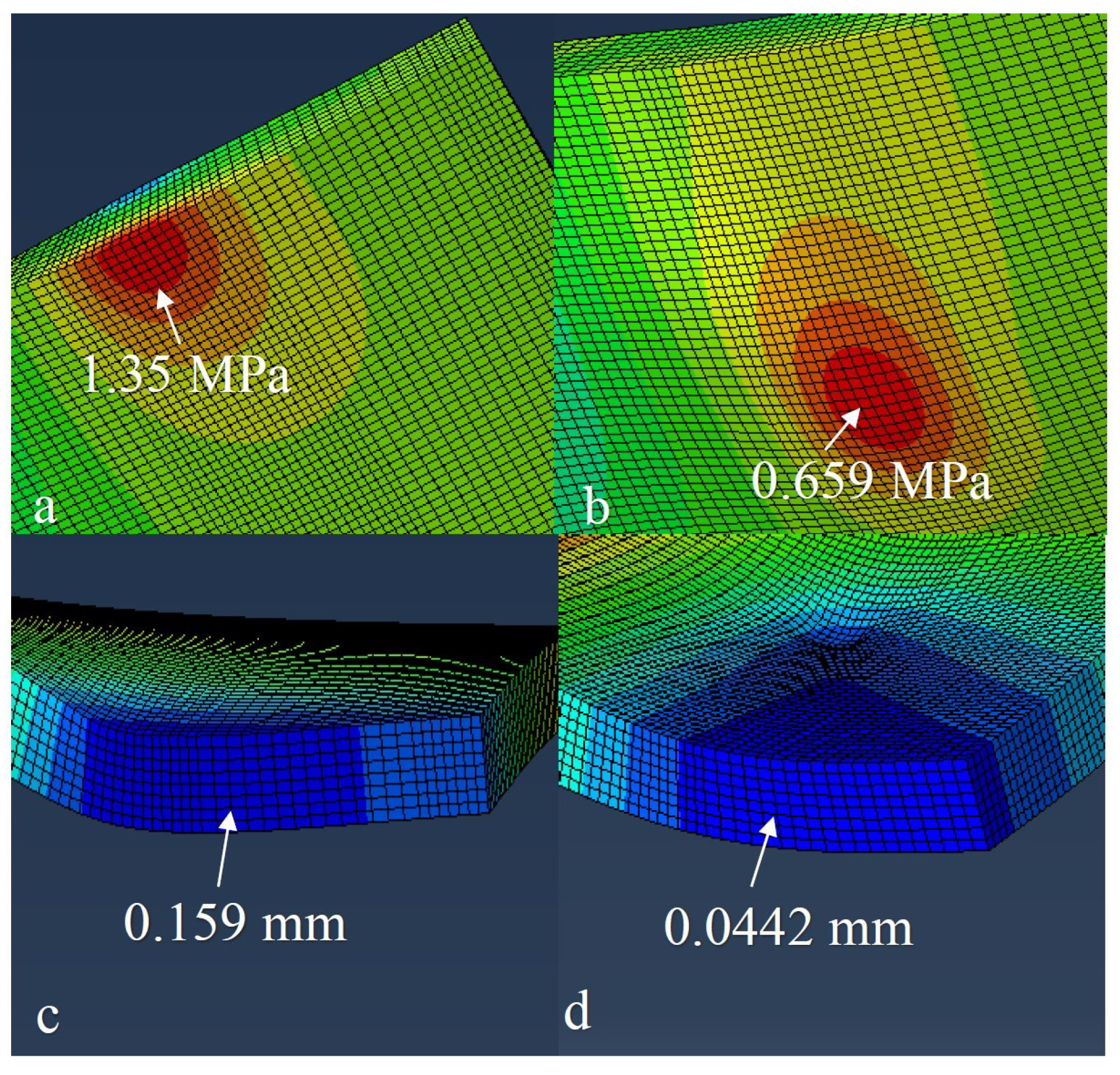
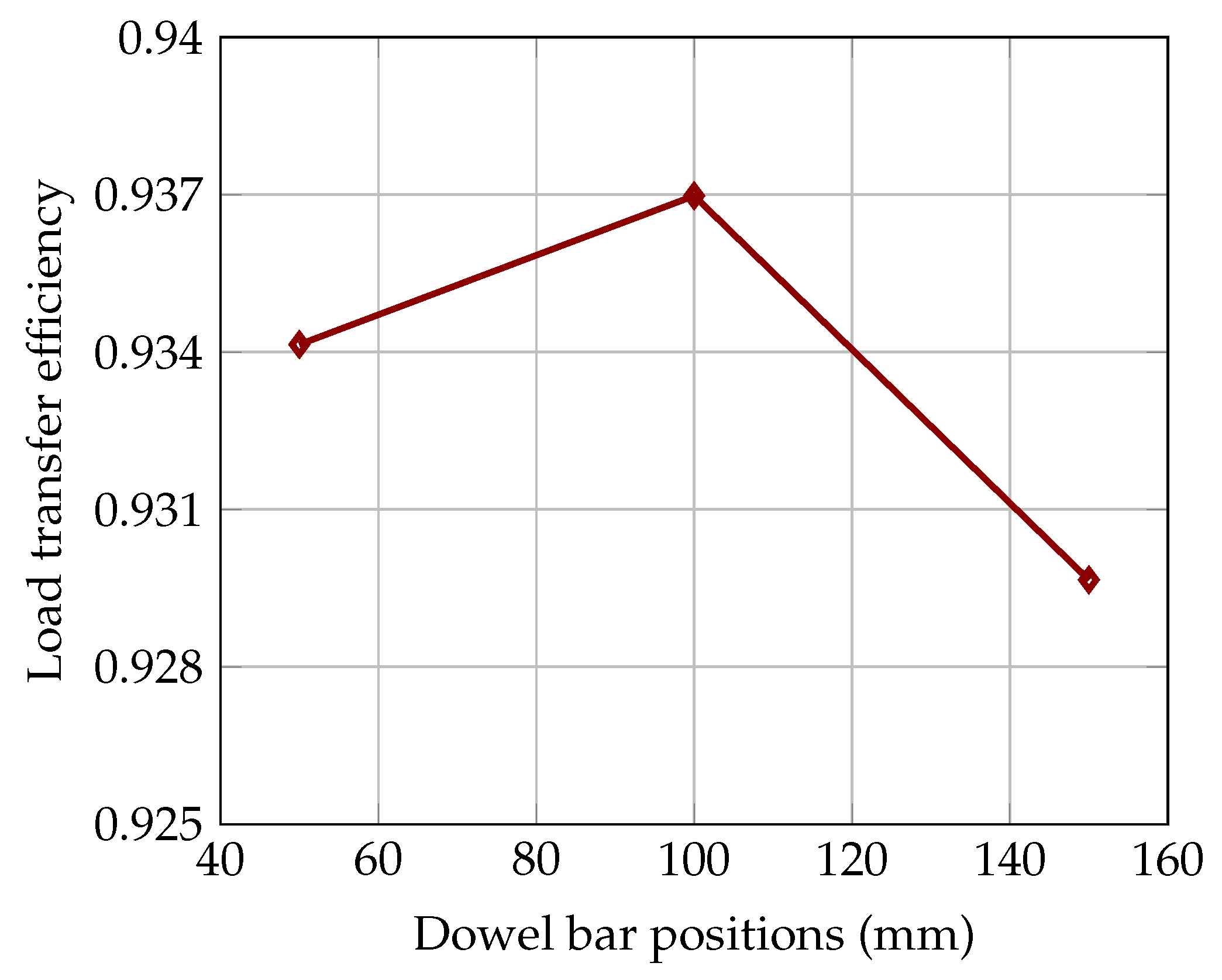
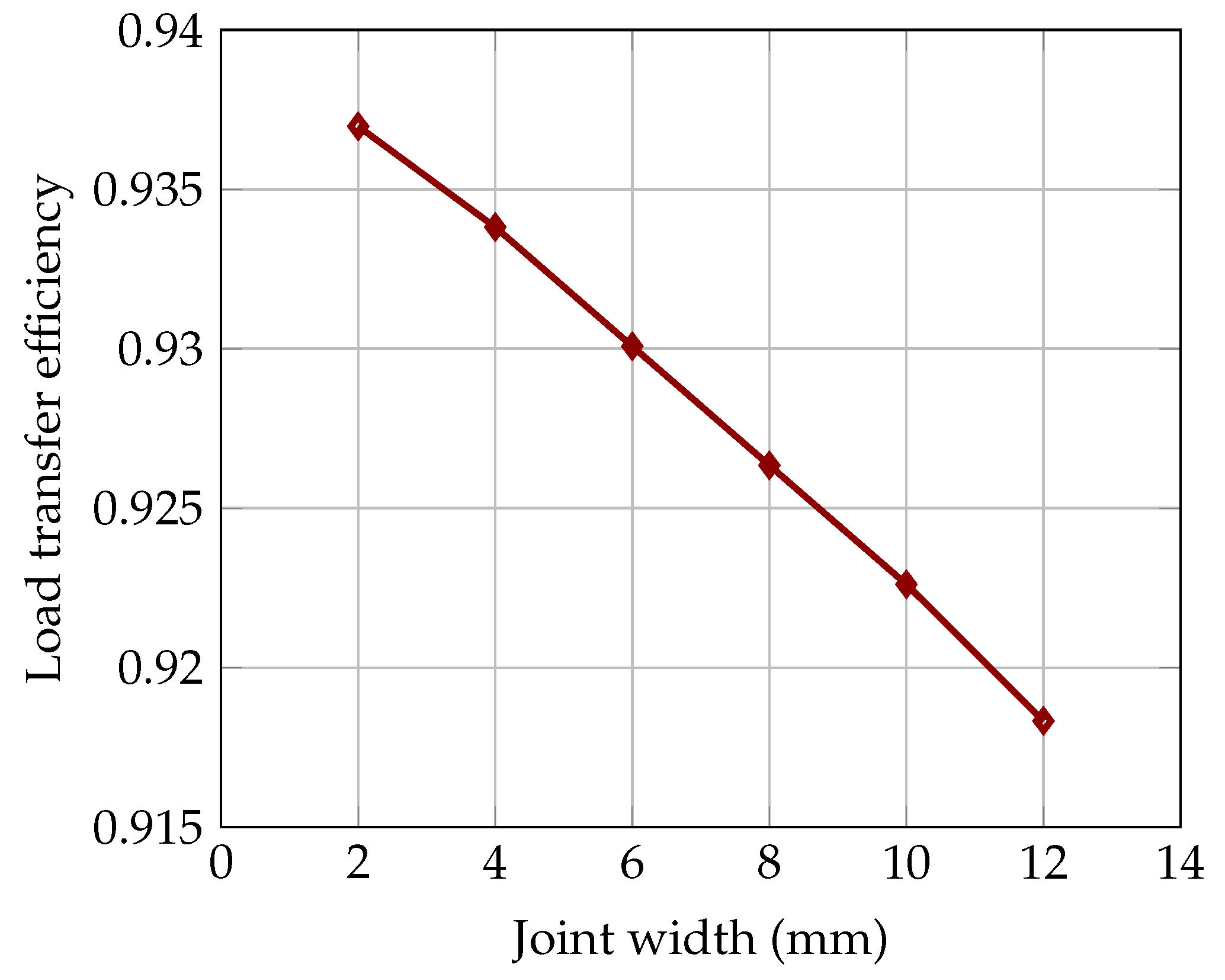
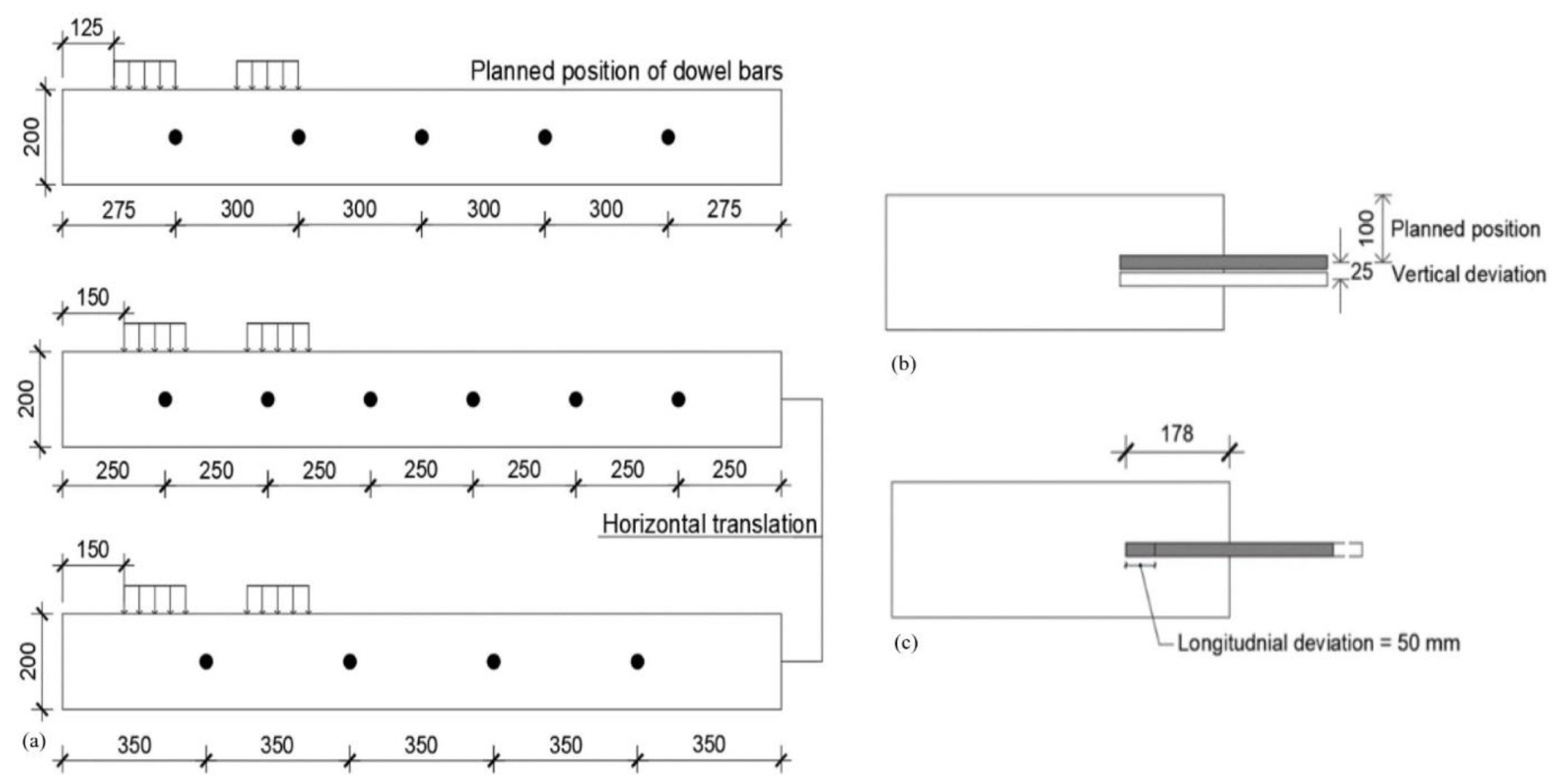
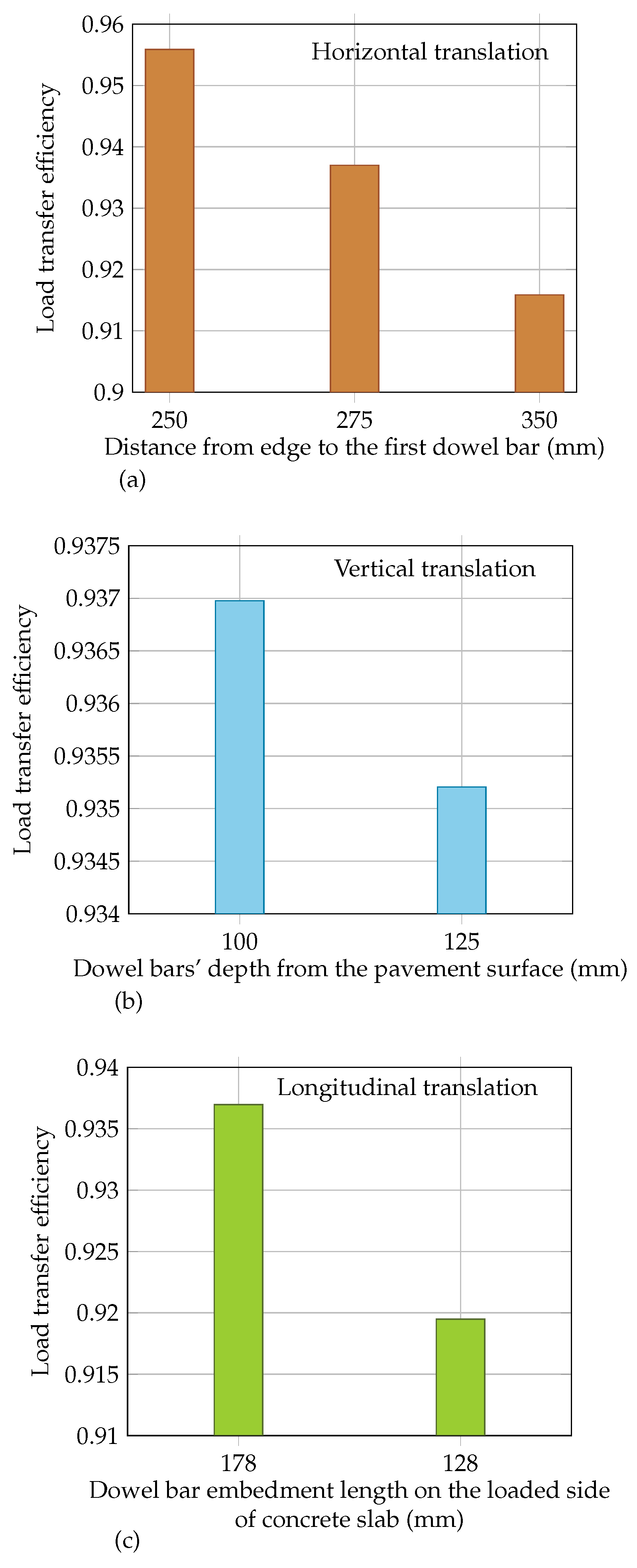
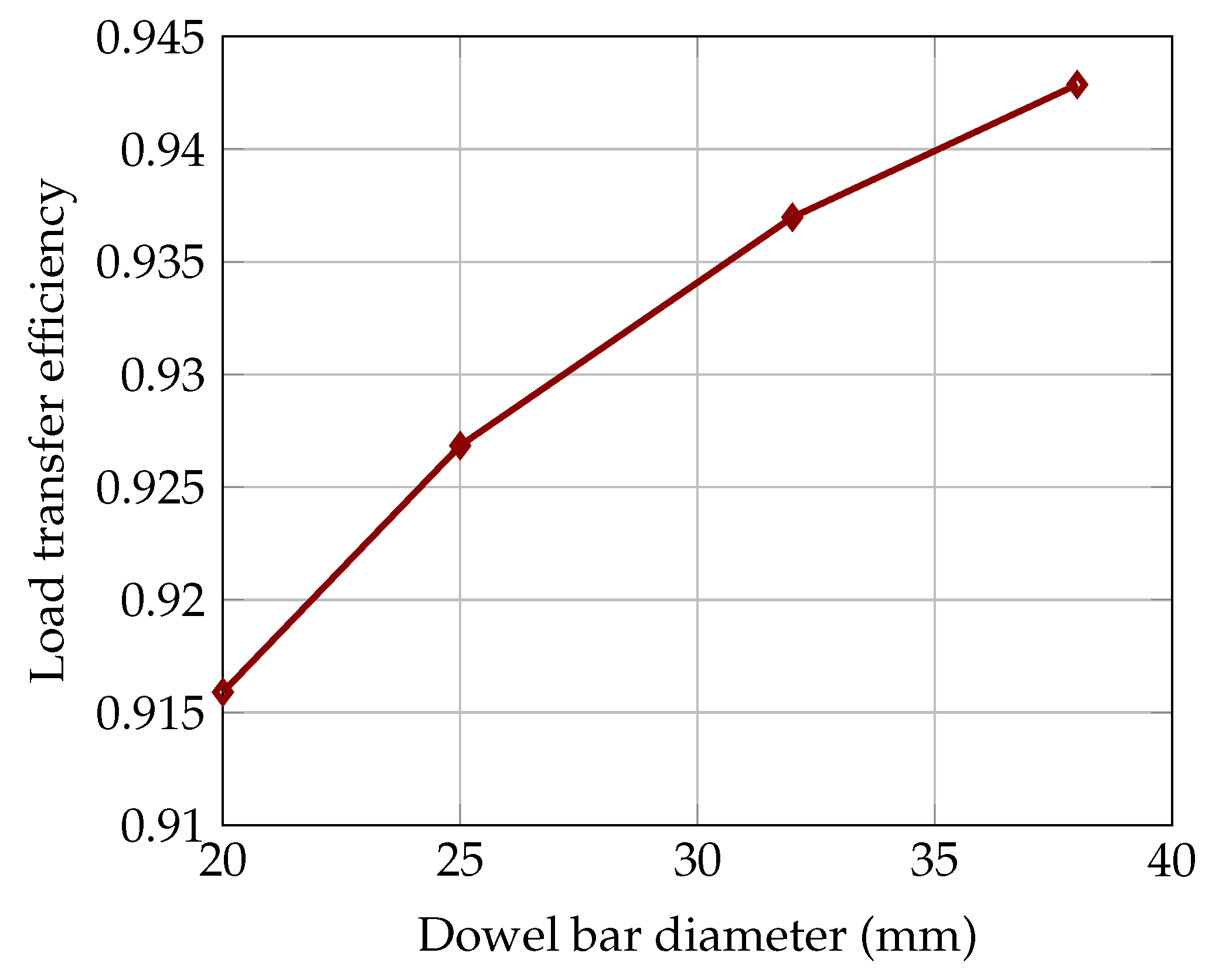

| Theme(s) | Method/Methods | Year and References |
|---|---|---|
| Numerical study of various parameters, i.e, slab—base interaction and dowel bar locking due to thermal gradient and shrinkage, mislocation of transverse joints, and dowel looseness. | Computational analysis | 2003 [28] |
| Effect of dowel bar deviation (horizontal skew and vertical tilt in rigid pavement), vertical displacement on load transfer capacity. | Computational analysis | 2016 [29] |
| Evaluation of stress field around dowel bar, effect of the type of debonding agent and dowel bar diameter on the pull-out force magnitude and dowel-concrete friction. | Computational analysis and experimental testing | 2003 [30] |
| Investigation of dowel bar installation in New Jersey based on various kinds of coatings (red paint, graphite oil, tar paint, transmission oil, and asphaltic oil) and protective treatments (hot rolling and galvanization on the dowel bar). | Experimental testing | 1955 [31] |
| Investigation of stress distribution in dowelled jointed concrete slabs due to temperature variations, considering different diameters of dowel bars. | Computational analysis | 2014 [32] |
| Analysis of dowel bar group action using different pavement configurations (slab thickness, concrete elastic modulus, and modulus of subgrade reaction), dowel bar system and wheel loading. | Computational analysis | 2009 [33] |
| Analysis of the structural response of JPCP due to dowel bar looseness utilizing the embedded formulation of a beam element technique for the dowel modelling. | Computational analysis | 2000 [34], 2014 [35] |
| Evaluation of JPCP response based on dowel bar horizontal skew and vertical tilt, interface bond between concrete slab and base and base type (asphalt- and cement0treated base). | Computational analysis | 2021 [36] |
| A study of the structural performance of JPCP considering different dowel bar configurations (standard and special), the influence of base layer on dowel joint behaviour and the effect of dowel bar arrangement on the stresses in concrete and dowel bar. | Computational analysis and experimental testing | 2018 [37] |
| Investigation of dowel bar geometry, spacing and subbase stiffness on the stress in the concrete slab and dowel bar. | Computational analysis | 2001 [38] |
| Investigation of LTE based on material properties (concrete and base layer), load magnitude and bond between the concrete slab and base. | Computational analysis | 2018 [39] |
| Investigation of concrete pavement response subjected to traffic loading and different environmental conditions. | Experimental testing and computational analysis | 1997 [40] |
| Evaluation of improperly aligned dowel bars (horizontal skew and vertical tilt) on joint performance by examining joint lockup and slab cracking. | Computational analysis | 2006 [41] |
| Effect of different parameters related to misaligned dowel bars on the performance of joints and stress states in concrete pavement. | Experimental testing and computational analysis | 2007 [42] |
| Materials | Parameters | Values | Unit |
|---|---|---|---|
| Concrete | Modulus of elasticity | 35,000 | MPa |
| Poisson’s ratio | 0.2 | - | |
| Base (Cement- bound gravel) | Modulus of elasticity | 8000 | MPa |
| Poisson’s ratio | 0.2 | - | |
| Subbase (gravel) | Modulus of elasticity | 160 | MPa |
| Poisson’s ratio | 0.35 | - | |
| Subgrade (sand) | Modulus of elasticity | 100 | MPa |
| Poisson’s ratio | 0.35 | - | |
| Steel dowel bar | Modulus of elasticity | 200,000 | MPa |
| Poisson’s ratio | 0.35 | - |
| Load Cases | Interior Loading | Edge Loading | Corner Loading | |||
|---|---|---|---|---|---|---|
| Analysis Method | W.M a | FE Model | W.M a | FE Model | W.M a | FE Model |
| Stress (MPa) | 0.835 | 0.659 | 1.47 | 1.35 | 1.613 | 0.651 |
| Deflection (mm) | 0.0675 | 0.0442 | 0.24 | 0.159 | 0.60 | 0.427 |
| Difference in stress (%) | 21.0 | 8.5 | 59.6 | |||
| Difference in deflection (%) | 34.4 | 33.7 | 28.7 | |||
| Slab | Stress/Deflection | Units | Dowel Bar Positions | ||
|---|---|---|---|---|---|
| Dowel Bar at the Top (h’ * = 50 mm) | Dowel Bar at the Centre (h’ * = 100 mm) | Dowel Bar a at the Bottom (h’ * = 150 mm) | |||
| Loaded slab | Stress () | MPa | 0.59 | 0.61 | 0.71 |
| Deflection () | mm | 0.3462 | 0.3459 | 0.3028 | |
| Unloaded slab | Deflection () | mm | 0.3234 | 0.3241 | 0.2815 |
| Joint Width mm | Deflection at the Loaded Slab Loaded Slab () mm | Deflection at the Unloaded Slab () mm |
|---|---|---|
| 2 | 0.3459 | 0.3241 |
| 4 | 0.346 | 0.3231 |
| 6 | 0.3461 | 0.3219 |
| 8 | 0.3462 | 0.3207 |
| 10 | 0.3463 | 0.3195 |
| 12 | 0.3465 | 0.3182 |
| Distance from Edge to the First Dowel Bar mm | Deflection at the Loaded Slab () mm | Deflection at the Unloaded Slab () mm |
|---|---|---|
| 250 | 0.3331 | 0.3184 |
| 275 | 0.3459 | 0.3241 |
| 350 | 0.3375 | 0.3091 |
| Vertical Depth of Dowel Bar mm | Deflection at the Loaded Slab () mm | Deflection at the Unloaded Slab () mm |
|---|---|---|
| 100 | 0.3459 | 0.3241 |
| 125 | 0.3025 | 0.2829 |
| Embedment Length of Dowel Bar at the Loaded Side of Slab mm | Deflection at the Loaded Slab () mm | Deflection at the Unloaded Slab () mm |
|---|---|---|
| 178 | 0.3459 | 0.3241 |
| 128 | 0.3465 | 0.3186 |
| Dowel Bar Diameter mm | Deflection at the Loaded Slab () mm | Deflection at the Unloaded Slab () mm |
|---|---|---|
| 20 | 0.3484 | 0.3191 |
| 25 | 0.3472 | 0.3218 |
| 32 | 0.3459 | 0.3241 |
| 38 | 0.3448 | 0.3251 |
| Coef. of Friction ν - | Deflection at the Loaded Slab () mm | Deflection at the Unloaded Slab () mm |
|---|---|---|
| 0.05 | 0.3459 | 0.3241 |
| 0.5 | 0.3458 | 0.3243 |
| 1 | 0.3458 | 0.3244 |
Disclaimer/Publisher’s Note: The statements, opinions and data contained in all publications are solely those of the individual author(s) and contributor(s) and not of MDPI and/or the editor(s). MDPI and/or the editor(s) disclaim responsibility for any injury to people or property resulting from any ideas, methods, instructions or products referred to in the content. |
© 2024 by the authors. Licensee MDPI, Basel, Switzerland. This article is an open access article distributed under the terms and conditions of the Creative Commons Attribution (CC BY) license (https://creativecommons.org/licenses/by/4.0/).
Share and Cite
Yaqoob, S.; Silfwerbrand, J.; Balieu, R.G.R. A Parametric Study Investigating the Dowel Bar Load Transfer Efficiency in Jointed Plain Concrete Pavement Using a Finite Element Model. Buildings 2024, 14, 1039. https://doi.org/10.3390/buildings14041039
Yaqoob S, Silfwerbrand J, Balieu RGR. A Parametric Study Investigating the Dowel Bar Load Transfer Efficiency in Jointed Plain Concrete Pavement Using a Finite Element Model. Buildings. 2024; 14(4):1039. https://doi.org/10.3390/buildings14041039
Chicago/Turabian StyleYaqoob, Saima, Johan Silfwerbrand, and Romain Gabriel Roger Balieu. 2024. "A Parametric Study Investigating the Dowel Bar Load Transfer Efficiency in Jointed Plain Concrete Pavement Using a Finite Element Model" Buildings 14, no. 4: 1039. https://doi.org/10.3390/buildings14041039
APA StyleYaqoob, S., Silfwerbrand, J., & Balieu, R. G. R. (2024). A Parametric Study Investigating the Dowel Bar Load Transfer Efficiency in Jointed Plain Concrete Pavement Using a Finite Element Model. Buildings, 14(4), 1039. https://doi.org/10.3390/buildings14041039








